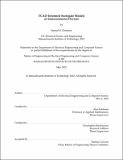TCAD-Informed Surrogate Models of Semiconductor Devices
Author(s)
Chinnery, Samuel B.
DownloadThesis PDF (3.349Mb)
Advisor
Edelman, Alan
Rackauckas, Christopher
Terms of use
Metadata
Show full item recordAbstract
Extensive research has been conducted over the last half-century to develop models of semiconductor devices for use in circuit analysis and simulation. Such models typically fall into one of two categories: “Cheap” analytical models that can be solved quickly but introduce significant error, and “expensive” physics-based models that achieve high accuracy at the price of prohibitive computation time. As electronic circuits grow to contain billions of active devices, there is a pressing need for new models that are both accurate and fast to compute.
In this thesis, we introduce Semiconductors.jl, a new semiconductor simulation tool written in the Julia programming language. We use Semiconductors.jl to implement performant surrogate models that approximate the behavior of fine-grained technology computer-aided design (TCAD) device models using a coarsified grid. The resulting surrogate models are shown to approximate the current-voltage characteristics of the fine-grained models to within a maximum error of 0.1% while using less than one tenth as many discretization nodes as the fine-grained baseline model.
Date issued
2022-05Department
Massachusetts Institute of Technology. Department of Electrical Engineering and Computer SciencePublisher
Massachusetts Institute of Technology